
White Pine (Pinus strobus) - This native species likes open,
sunny habitats and is among the most long-lived of trees. Its
bluish-green needles are grouped in bundles of five, one of the
features which help to identify it as a white pine.
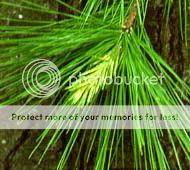
The bark of young white pines is smooth, whereas older trees
have broad, flat, and scaly ridges.
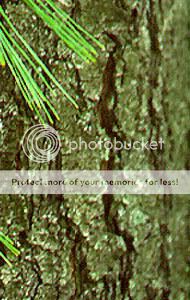
All conifers, or cone-bearing trees, typically have a central
stem (trunk) from which branches come off in whirls. The very tip
of this central stem is called the leader, because it leads the
upward growth of the tree. White pines are one of the most
important and tallest of timber trees; straight-grained and easily
worked, its food is valuable in house construction and whole trunks
were once used for ship masts.
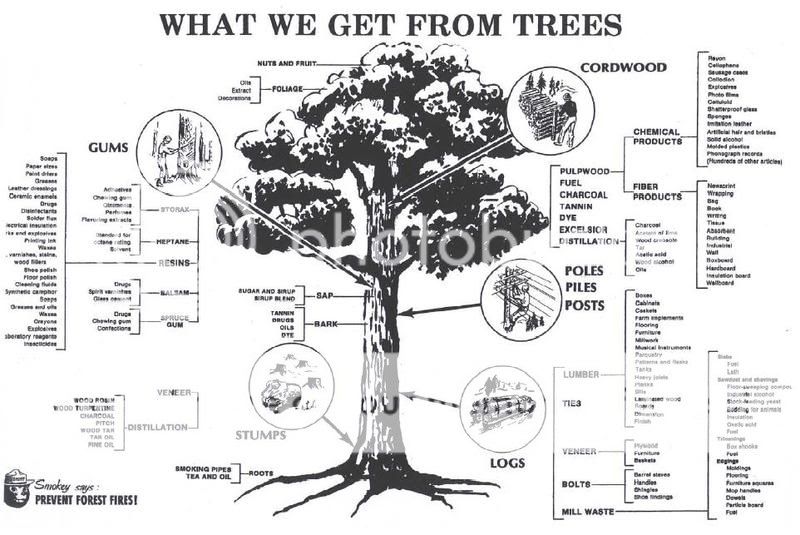
So extensively was it lumbered that few virgin trees remain.
Imagine your backyard filled with 500-year-old white pines that
seemed to touch the sky, trees so wide that even two people could
not put their arms around them. That is the way the Eastern US once
was.

The Carter Pines Community Park is a 24 tract within the Town of
Hillsville and is owned and administered by Carroll County. It is
the largest town park in South West Virginia. The tract contains
one of the first and last surviving white pine plantings in the
state. A five-acre remnant stand was planted in the 1930s. Several
acres are replanted native hardwoods. The State of Virginia mass
planted stands of white pine after the resource was nearly depleted
from the industrialization period. This stand is one of the few
remaining from the old forests that once stood proudly.
In forested settings, white pine grows rapidly on good sites,
exceeding 100 feet in height and averaging 2 to 3 feet in diameter.
The trunk is usually straight with a pyramidal crown. White pine
was extensively used in construction when old-growth white pine
forests were abundant. The Eastern White Pine is a large, fast
growing pine tree that is one of the most widely planted pine trees
in the United states. It has a unique wildlife value where super
canopy trees promote structural diversity of forests and providing
nesting and denning sites.

The geology of an area impacts white pine growth. The geological
features of Carroll County here has such an immense quantity of
granite. The geology is comprised of Laurentian gneissoid series as
much of the mountains here in the Blue Ridge. The dip of the rocks
has the general appearance of being monoclinal southwardly,or
rather southeastwardly, common to most of the rocks of this region;
but in places there were once great folds or anticlinals, the
crests of which have been denuded and swept away in the lapse of
time since they were so folded, leaving both sides of the fold with
the same general average inclination. White Pines thrive on
mountain sides in elevated terrain. The bedrock beneath these trees
was mainly sandstone, started as a sediment on a seabed 300 million
years ago. Techtonic collisions later created the mountains.
Metamorphic rock became igneous then granitic. Later a cooler
climate during the ice age supported white pine and colonies were
established. White pines and white cedar are also found here,
carried south by the outwash of glaciers long ago.

The entire Hillsville area is under laid by metamorphic and
igneous rock. The Blue Ridge Mountain rocks are of the Precambrian
and early Paleozoic age created in the mountain-making
processes.

Vegetation regions are geographical areas characterized by
distinct plant communities. Community composition, determined
primarily by climate (temperature, precipitation, sunlight), are
affected by factors such as geology, soil composition and erosion,
water drainage patterns and human interference.
The soils developed slowly over a long period of time. The
physical and chemical composition of the parent material played a
major role in what kind of soils developed. The effect of climate
and the plants and animals that lived and died here are other
contributing factors. Although soil contains many living things, it
is also composed of non-living matter such as minerals, water, and
air. How much water and air found in soil depends upon weather,
water uptake by plants growing there, the lay of the land, texture
of the topsoil and subsoil, and groundwater levels that make up the
surficial layer on the earth.
As weather, seasons, and land-use change, the level of the
groundwater and soil moisture fluctuates. Wet sand in spring, for
example, may be dried out in fall. Moisture content of topsoil also
depends on the type of subsoil. A rich loam topsoil, for instance,
may not be especially productive if the subsoil is
moisture-leaching gravel. Texture is also a common way to classify
soils. It is determined by the amount of sand, silt, and clay found
in the soil. Sand particles are the largest, and clay particles are
the smallest. Silt particles fall between sand and clay for size.
As you might expect, clay is capable of holding much more water
than sand because the clay particles are so much smaller and do not
leave as many spaces for the water to leach through.
The “Surficial Layer” of earth that best promotes pine tree
growth is sandy or loamy soils, but the trees themselves can grow
right out of bedrock. Sandy soils are loose, light soils that are
easy to work with. They usually drain water readily and are low in
nutrients. Sandy soils dry out quickly as they do not hold water.
Instead they absorb it, at a rate of more than two inches of water
per hour, and it leaches through to lower layers. Therefore, sandy
soils support drought-resistant vegetation such as white pines.
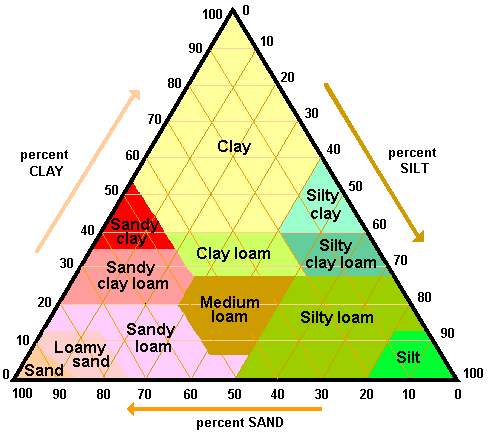
Clay soils are heavy soils rich in nutrients but difficult to
work with. They absorb less than a quarter-inch of water per hour,
and therefore are capable of holding a lot of water. Therefore clay
soils are associated with vegetation communities that tolerate high
water content in the soil such as swamps and floodplain
forests.
Loamy soils are intermediate between sands and clays. Composed
of many different-sized soil particles, they combine fertility with
moisture-holding capacity. Therefore, these soils are able to
support a wide variety of vegetation, especially hardwood forest
that include white pine.
Higher elevation mountainous terrain or northern areas where
soils tend to be coarser, the growing season is shorter, and the
climate is cooler also tend to support successful white pine
communities.
The White Pine plays a large ecological role. It’s
characteristics include an exploitive ecological strategy of light
seed and rapid growth. It can produce seed at an early age such as
5-10 years. Cones mature in the fall and seeds are dispersed by the
wind. It can be found in single plots but generally is mixed with
other hardwoods. It does well competitively with other trees, as
it’s rapid growth helps it succeed among slowly growing hardwoods
such as oaks.
In pure stands white pine is a fast-growing, early successional
invader of disturbed habitats, but it is long-lived and apparently
persistent in more successionally stable mixed forests. Communities
in this group occur throughout the Virginia mountains. Trees of up
to 450 years old have been reported. However the rarity of that is
growing due to several climatic and infestation conditions.
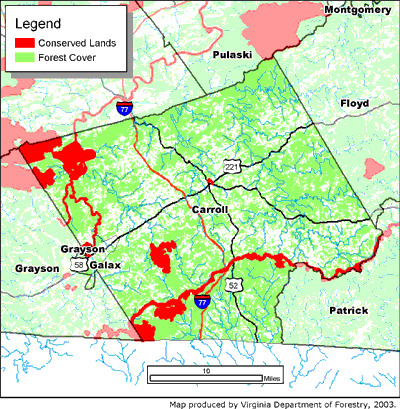
White pines play an important role in forest succession. Fire
has played an important role in the ecology of white pine during
the pre-settlement and post-settlement periods throughout eastern
North America. Natural ground fire actually helps white pines
reproduce. The fire burns up leaf litter and underbrush on the
forest floor while the mature white pines are protected by their
thick bark.

The fire creates ideal conditions for the next crop of white
pine seeds to take root and survive. Fire exposes the earth’s soil,
releases nutrients into the ground from the leaf litter, and kills
hardwoods such as sugar maple and beech that compete with white
pine for space. However, white pine is also able to regenerate
without the aid of fire because it is able to tolerate a variety of
sun-shade conditions, except for extremely dense shade.

These pine are often the first tree species found on high
elevation sites after a major disturbance to the earth’s surface
such as a fire or landslide events. They can be found at the
highest elevations forming the a tree line on exposed, dry, rocky
slopes. In mountainous regions where fracture traces and lineaments
have created faults in the underlying rock structures that conduct
water and cause slope instability, rapid runoff, and earth slide
conditions the white pine seems to thrive as if nothing had
happened. White Pine old-growth remnants are always on steep rocky
slopes that discouraged loggers back in the late 1800s.
Pines serve to protect watersheds from erosion of the earth
beneath them whether rock or soil, and can regulate snow capture
and melt to slow down flooding events from hydrological surface
water. White Pine Tree planting programs help reduce global warming
as well. As trees grow, they help stop global warming by removing
carbon dioxide from the air, storing carbon in the trees and the
soil, and releasing oxygen into the atmosphere.
Decline and mortality in eastern white pine is being attributed
to moisture extremes during the late 1990's, followed by
stress-dependent insects and diseases. Affected trees are generally
20-30 years old and growing in groups or pockets within pure white
pine plantings.
Droughts of 1988 and 1991 mark the beginning of the domino
effect resulting in white pine pocket mortality. The white pine
weevil (WPW) is found throughout Virginia. Its preferred hosts are
eastern white pine and Norway spruce, but it can attack Scotch and
other pines as well. Drought stress predisposed the trees to
extremely heavy pine bark infestations. Infestations were so heavy,
especially on the more protected side of the tree and just below
the live crown, that the trunks of trees appeared white-washed and
the cambium was damaged. Cambium damage opens the door for
infection by a variety of opportunistic secondary fungal
pathogens.
Many bark beetles are also attracted to these stressed trees.
Their boring activity kills additional cambium and can cause rapid
decline and death in trees that are already extremely stressed.
This complex of factors results in weakened trees, which often
causes the trunk to break just below the live crown. Mortality is
also caused by restriction of fluid movement through damaged
cambium and blocked vessels.
In unthinned stands of pure white pine, trees will stagnate and
become stressed before they thin themselves and go back to the dust
of the earth where they first took rise. This stress from
overcrowding predisposes the trees to insects, pathogens, etc.,
which do not normally affect healthy trees.
Pines can give us a perspective about Earth's history, creating
a timeline for such events as when the first life on Earth
appeared, the Ice Age, the first modern humans, when the tree was
born, and when the modern world began. Tree rings can tell a story
about the evolution of Earth's 5-billion-year history. Dendrology
is the process of tree-ring analysis which in some cases can be a
more accurate method than radiocarbon dating or rocks. Besides
dating trees and revealing past climate data, dendrochronology is
used to provide information about glacial activity, volcanic
events, and even past insect outbreaks.
Large cells, made during the spring when rain is abundant, mark
the start of a tree ring. As the seasons continue, growth slows and
then finally stops until the following spring. A continuum of cell
growth size can therefore be seen for each year. The sizes of each
ring depend on many factors, including location, temperature, soil
condition, wind, snow accumulation, sunlight, land gradient, and
tree physiology. In addition, ring growth is not always annual, so
a ring may be absent from a core sample. These are some reasons why
scientists can't rely solely on counting rings and must use cross
dating from multiple samples to ensure accurate age
determination.
One of the oldest pine trees tracked on earth is know as
Methuselah, and grows in California. It’s roots started in 2,000
BC. It is a bristlecone pine.
Several specialized sciences are based on dendrology for which
High Elevation White Pines play a significant role.
Dendrochronology is the science that uses tree rings dated to their
exact year of formation to analyze temporal and spatial patterns of
processes in the physical and cultural sciences. It is based on the
Uniformitarian Principle. This principle states that physical and
biological processes that link current environmental processes with
current patterns of tree growth must have been in operation in the
past. In other words, "the present is the key to the past,"
originally stated by James Hutton in 1785. However,
dendrochronology adds a new "twist" to this principle: "the past is
the key to the future." In other words, by knowing environmental
conditions that operated in the past (by analyzing such conditions
in tree rings), we can better predict and/or manage such
environmental conditions in the future.
Dendrogeolmorphology is used for the dating of land surfaces
using tree ring analysis in the earth sciences. The science uses
tree rings to date earth surface processes that created, altered,
or shaped the landscape. Example: analyzing changes in tree growth
patterns via tree rings to date a series of landslide events.
Dendroglaciology is the science that uses tree rings to date and
study past and present changes in glaciers. Example: dating the
inside rings of trees on moraines to establish the approximate date
of a glacial advance. Dendrohydrology is the science that uses tree
rings to study changes in river flow, surface runoff, and lake
levels. Example: dating when trees were inundated to determine the
sequence of lake level. Dendroclimatology is the science that
studies tree rings to detect increases in carbon dioxide and severe
climatic changes.
The following examples of tree rings show how scientists can
date specific earth events:

This picture shows a row of disrupted cells in a tree ring from
a bristlecone pine (Pinus longaeva) growing in the White Mountains
of California (photo © R.K. Adams and H.D. Grissino-Mayer). This is
no ordinary frost ring. This one was formed in the year 1627 B.C.,
and is connected with the eruption of Thera in the Mediterranean
Sea.

This ponderosa pine tree (Pinus ponderosa) was growing alongside
a stream in Pine Canyon in the Chiricahua Mountains of southeastern
Arizona (photo © H.D. Grissino-Mayer). The impact scar on the right
was from a flood. Notice the resin behind the scar and how the tree
leaned to its left after it was struck by the flood water.

This image shows a very nice fire scar in a ponderosa pine.
(Laboratory of Tree-Ring Research)
Surveyors use surface geology maps, soil maps, and other
technical data based on climate and geology to determine the types
of vegetation present. Each family of rock weathers and is
organically modified to form soils of characteristic pH and mineral
profile, lending a recognizable look to the terrain and natural
vegetation, and directs the agricultural uses to which man may put
the land. To a significant degree it determines the wild flowers,
birds, fish and game to be found. In general, heights of land are
free of glacial overburden and are covered by vegetation more
reflecting the underlying bedrock. Here in the Virginia Mountains,
pine thrive in the higher, drier ridges. The tremendous variations
in topography, exposures to sunlight, and soil types provide a
diverse array of habitats that support many hundreds of interesting
plant species.
These lofty white pines, grandchildren of the forest primeval,
jut into the bright blue sky where the bedrock has been exposed in
several areas by the erosive action. The hierarchy included canopy
opening, land type, geological feature, and weathering. All played
a role in their success here.
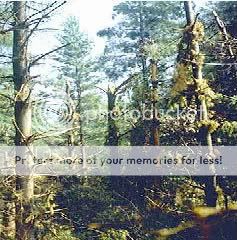
Old stands of white pines such as this one can be rare to find,
especially those towering upwards of 100’. During the pioneering
time to present, the trees have been harvested for log homes and
just about anything else you can think of. However, new growth
stands planted for construction and other products utilized from
the tree can be cultivated with maximum growth for short periods
and clear cutting within a few years for the value of their
products.
To visit one of the first and last surviving white pine tracts
in the State of Virginia, travel State Route 221 north to East
Grayson Street. Make the following estimations and calculations
then email us. This cache is handicapped accessible as paved trails
lead from the parking area to the stand of pines. The park is open
from 8 AM to 8 PM daily.
1. Estimate the height of the tallest pine standing within the
tract.
a/ 50-75 feet b/75-100 feet c/100-125 feet d/125-150 feet
2. Identify the color of the soil here that has promoted the
growth of the last standing pines.
3. Shoot an elevation at the site for one of the first and last
tracts of pines standing.
Take a picture of your GPS with the majestic towering pines in
the background.
After cutting down a dead pine on his farm, Aldo Leopold
recorded his thoughts in the Sand County Almanac: “Fragrant little
chips of history, spewed from the saw cut... our saw biting its
way, stroke by stroke, decade by decade, into the chronology of a
lifetime, written changes over time.”
Trees are one of the best methods we have for looking back into
time. What can we learn from tree rings? The answer is limited only
by our ability to decipher their stories. For scientists, white
pines are some of the best story tellers around when it comes to
identifying what the earth beneath them has experienced.
